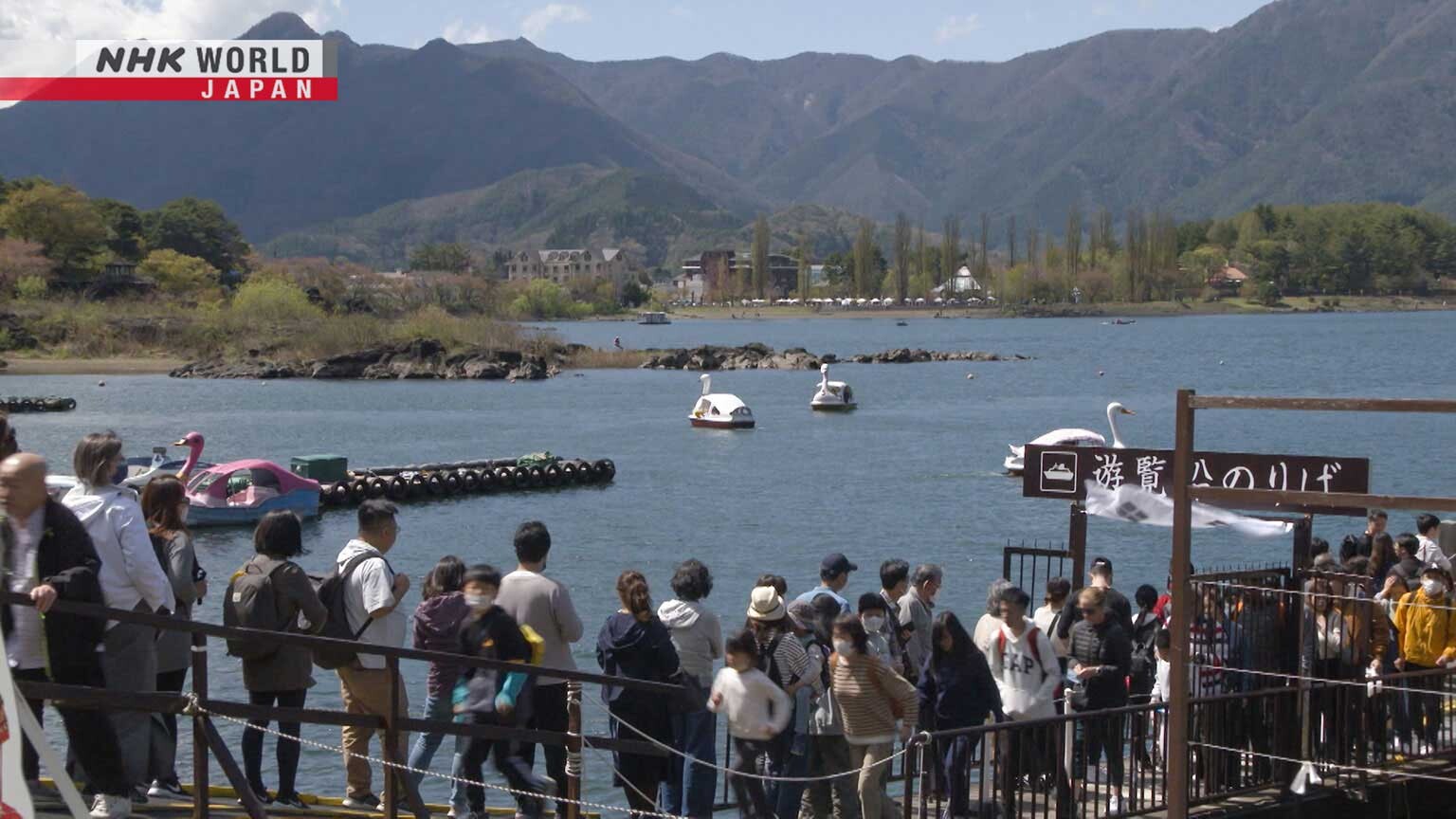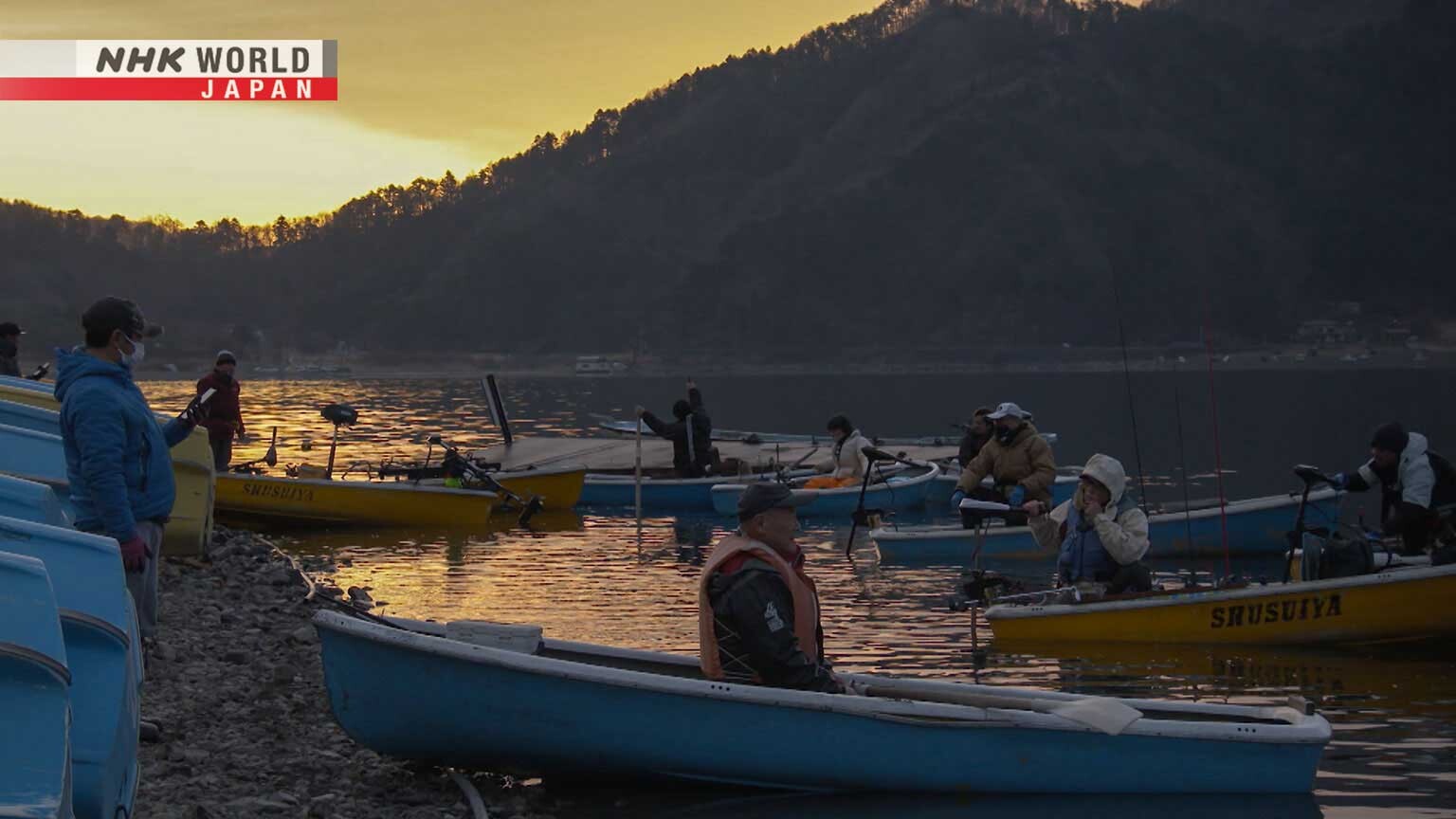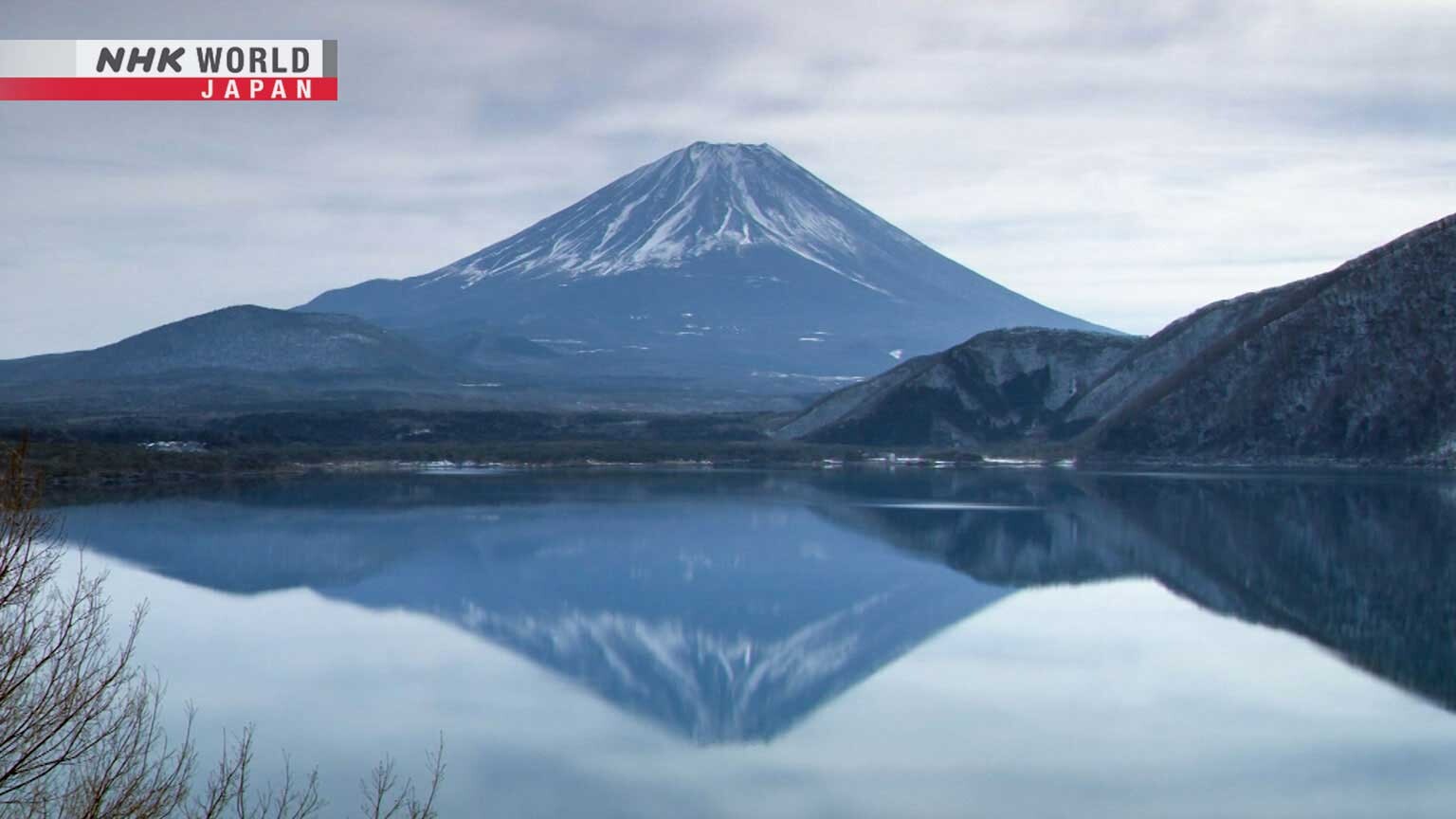Fuji Five Lakes: The Water of Life
Japanese people have, since time immemorial, loved Mt. Fuji, Japan's highest peak. Around the mountain's base, there are five lakes of various sizes. These are the Fuji Five Lakes, which are found in Yamanashi Prefecture, on the north side of Mt. Fuji. The five lakes were formed by Mt. Fuji's repeated volcanic eruptions, when lava flows blocked rivers or split existing lakes. In times past, and still today, the lakes are an essential part of life for residents along their shores.
Paradise on the Shore

The Fuji Five Lakes region attracts around 6 million tourists every year. Lake Kawaguchi receives the most visitors. In the Funatsu district, alongside the lake, there are more than 200 hotels and inns. One of those hotels played a pioneering role in transforming Lake Kawaguchi into a tourist resort. The ancestors of the hotel's proprietor were Oshi, religious figures who would provide lodging to people visiting Mt. Fuji, also praying for their safety en route.
100 Years a Princess

March 20 each year marks the start of the fishing season in Lake Sai. The lake is stocked with a species of salmon, whose Japanese name translates to "Himemasu" or "Princess Trout." However, the lake once contained hardly any fish at all. Following a major eruption in the year 864, hot lava flowed into the lake, heating it to extremes. It was the Princess Trout that revived the area's fortunes. Now a fish farm on the banks of the lake produces and releases 200,000 fry per year.
A Lifeline for the Dairy Farm

Fujigane, six kilometers away from Lake Motosu, is an area renowned for dairy farming. People first moved to the area in 1946 under a government program that granted land to newly arriving pioneers. However, the barren land was on a lava plateau 200 meters above the lake. There was no adequate source of water, let alone proper piping. It was not until 1965 that water from Lake Motosu, which is fed by underground aquifers and serves as a natural, abundant and clean water source, finally reached Fujigane.
Transcript
From the four winds and the scent of the earth, come the color of the seasons.
Exploring the four seasons of Japan.
Mt. Fuji, Japan's highest peak, has been loved by Japanese people since time immemorial.
Around the mountain's base, there are five lakes of various sizes.
These are the Fuji Five Lakes.
The smallest of the lakes, Lake Shoji,
is a great place to canoe when the spring comes around.
Many of Japan's best canoeists, including a high school champion and an Olympian,
learned to canoe on this lake.
They are mating, it is the season of love.
At Lake Yamanaka, young swans are ready to leave the nest.
Lake Motosu is an important source of water in times of drought.
Water pipes reached local villages, which previously relied on rainwater, in 1965.
We can't survive without water.
Water brings life.
The Fuji Five Lakes are an important lifeline for local people.
OK? I'll tighten it up.
OK.
On the banks of Lake Kawaguchi,
local people light up the cherry trees for the enjoyment of tourists.
Our stage for today is the Fuji Five Lakes,
some of the best places in Japan for enjoying views of the famous mountain.
The Fuji Five Lakes are found in Yamanashi Prefecture, on the north side of Mt. Fuji.
The five lakes, which lie at an altitude of around 900 m,
were formed by Mount Fuji's repeated volcanic eruptions,
when lava flows blocked rivers or split existing lakes.
Mt. Fuji has erupted around 10 times since earliest records in the 8th century.
The five lakes are thought to have been formed by the largest eruption in 864.
The Fuji Five Lakes region attracts around 6 million tourists per year.
Lake Kawaguchi receives the most visitors.
In the Funatsu District, alongside the lake, there are more than 200 hotels and inns.
One of those hotels played a pioneering role in transforming Lake Kawaguchi into a tourist resort.
It was founded around 90 years ago.
Its architecture incorporates modern Western elements, which, at the time it was built, were rare.
The hotel is famous for the views from its rooms,
which were designed to enhance the beauty of the light,
and the feel of the breeze, coming from the lake.
Welcome to our new team members.
Ide Yasunari, the proprietor, is descended from a family of people who welcomed travelers to the region.
These ancestors were Oshi, religious figures who would provide lodging to people visiting Mt. Fuji,
also praying for their safety en route.
It was in around the 12th century, after the major eruption subsided,
that religious beliefs grew up around Mt. Fuji, seeing it as a source of spiritual power.
Later, in Japan's samurai times, more than 100 inns, run by Oshi,
spread along the shore of Lake Kawaguchi, near to the start of the climbing route.
One of the inns still stands in the grounds of the hotel.
It is more than 300 years old.
It's quite spacious.
This is where we think they used to eat.
Further inside is likely where people slept.
The Oshi looked after guests by providing rainwear, warm clothes, and food for their onward journey.
"Good evening."
Several years ago, a large volume of documents written by the Oshi were found in Yasunari's house.
He asked a local expert to read and analyze them.
This document here...
It's really interesting to see where the Oshi went...
This document records the business activities of Oshi in the 18th century or thereabouts,
as they travelled to neighboring prefectures.
The Oshi also travelled, selling charms and offering prayers for money.
Back then, over 1,000 people lived in Kawaguchi, but they could only grow crops to feed 300 people.
This meant they needed to travel elsewhere to earn their income.
The document was found in a collection belonging to Yasunari's grandfather...
...Takanari, who was the founder and first owner of the hotel.
In the early 20th century, when Takanari was young,
religious devotion to Mt. Fuji had become less common, and Oshi were struggling economically.
Some went to seek their fortune in the United States.
At the age of 25, Takanari decided to do likewise.
In the US, Takanari saw many resort hotels,
and this reminded him of the work of his ancestors.
Five years after returning to Japan, at the age of 32,
he started building a hotel on the banks of Lake Kawaguchi.
My grandfather was able to realize his dream.
Now there're so many hotels. You can see all the lights on the opposite shore.
So many people love to come here.
In his later years Takanari said:
"Having been born into this world, I want to work for the benefit of future generations."
"I hope to turn our village into a paradise for visitors."
It is 6 o'clock in the morning by Lake Sai.
Today, March 20th, marks the start of the fishing season.
Please, go ahead.
Many people have been waiting for the opportunity to start fishing.
They are all hoping to catch an example of local royalty.
The lake is stocked with a species of salmon, whose Japanese name, "Himemasu" translates to "Princess Trout."
I've caught 3 of them.
"I love the way they shine."
"I always eat these raw."
The texture is so smooth. That's why I come here.
However, while this lake is now well-stocked with the Princess Trout,
it once contained hardly any fish at all.
That is because, during the major eruption of 864,
hot lava flowed into the lake, heating it to extremes.
Historical records state that "the lake's water boiled and all its fish and turtles died."
After the lake boiled, no one could fish there.
Instead, local people grew vegetables and wheat in the limited space along the lake shore.
It was the Princess Trout that revived the area's fortunes.
A fish farm on the banks of the lake produces and releases 200,000 fry per year.
Miura Hisashi is one of the fish farmers and the leader of the local fishing cooperative.
The Kokanee salmon, or Princess Trout, as we call them, get ill very easily.
We take very good care of them.
We are very proud of these fish.
Of all river fish, these taste the best.
The Princess Trout originally thrived in the cold, clear lakes of Hokkaido and other parts of northern Japan.
The fry are particularly delicate,
quickly becoming weak unless the water temperature is kept between 10 and 13 degrees Celsius.
However, Lake Sai is also a good environment for the fish.
The lake's underground water sources filter through the volcanic rock,
keeping water quality and temperature suitable for the fish throughout the year.
The Yamanashi Prefectural Government began fish farming here in 1912,
seven years after the establishment of Japan's first successful fish farm.
Hisashi's grandfather, Takaharu, was one of the local officials involved in the project.
He built a fish farming tank on land near his house,
with the whole family pitching in to ensure their efforts succeeded.
The farming of Princess Trout went on to become a staple of the local economy.
It is the first day of the fishing season.
Every year, the Miura family celebrates the occasion by gathering to enjoy a fish feast.
You can see here the fish has excellent color,
coming out in pink, just like a princess should.
Isn't it amazing?
These are wonderful fish, so we take care to prepare them well.
Takaharu loved one particular dish cooked with the fish,
which is on the menu whenever the family celebrates.
If you do it like this, you can remove the meat.
The belly of the roasted fish is stuffed with ginger, leeks, and miso, and then crumbled together.
Hisashi loves the unique aroma of this dish,
enjoying it alongside rice cooked together with the fish.
What a feast.
Boiled, fried, or raw,
...the Princess Trout are a delicious addition to this lakeside spread.
Our late grandfather must be pleased to see the fish farming he started succeed.
He's looking down from above.
His grandson is carrying on his wishes.
While people are fishing on the lake, Hisashi, riding in his boat, checks up on them all.
Hello.
- "How are the fish?"
- I can't catch anything.
"Really?"
- "How deep are you fishing?"
- About 15m.
They are having good luck over there at 30m down.
Princess Trout, can you continue to bring us the goodness of the lake?
- "Look!"
- So many notes.
Even a 5,000 yen.
"Aren't you lucky seeing this?"
"You'll get rich."
Lake Motosu is a popular destination, even featuring on some of Japan's 1000 yen notes.
The far side of the lake, at the foot of Mt. Fuji, is renowned for dairy farming.
Fujigane is home to 28 dairy farms with a total of more than 2500 head of dairy cattle.
With a good breeze today and fine weather, this will dry quickly.
Aoyagi Mizuyo has lived in the area for more than 60 years.
She rears 50 cows.
She milks the cows twice a day,
working from 5 o'clock in the morning until past 10 o'clock at night.
Since losing her husband around 20 years ago,
she has run the farm together with her son Katsumi.
Stop that, it hurts.
She can understand you know.
She stops when you tell her off.
Mizuyo moved to the area in 1961, at the age of 18,
after her mother, a public health nurse, was employed locally.
Two years later, she married her husband, a dairy farmer.
She learned about life in Fujigane from Misao, her mother-in-law.
"What was your mother-in-law like?"
When we ate, she would stop for one cup of tea,
turn around, put her shoes on, and go straight back out into the field.
She never rested.
Misao moved to the area in 1946 under a government program that granted land to newly arriving pioneers.
However, the barren land was on a lava plateau, six kilometers from the lake and 200 meters above it.
It was previously a military range.
There was no adequate source of water, let alone a proper piped supply.
We took it in turns to come here for water.
- "Was it enough?"
- No, not at all.
This is Takeuchi Seiichi, a member of the agricultural cooperative
who back then was tasked with securing water for the residents.
At the time, they could bore wells no deeper than 150 m,
and they still could hardly find water.
I tried to sleep but couldn't.
The lives of hundreds of people were at stake.
During the winter of their 11th year on the land, with pond water and rainwater both lacking,
they were forced to ask the Self-Defense Forces for help.
In the end, the residents turned to Lake Motosu,
6 km away, which presented some difficulties as a water source.
The lake is in fact well fed by underground aquifers,
producing a natural, abundant, and clean source of water.
However, when Seiichi asked permission from the local government to use the water,
he was told that the water usage rights had already been sold to a nearby metal processing company.
Seiichi calculated the requirements of the residents and cattle in Fujigane
to convince the company that the lake's water level would be barely affected by their water demands.
Eventually, he received the permission of both the local government and the metal processing company,
and work on providing a water supply began.
After two years of work, in 1965, water from Lake Motosu finally reached Fujigane.
When they said that water was coming out from the pipes, everyone crowded around,
and there was a huge commotion.
"My mother-in-law cried when she realized that our water problems were over."
Here you go.
Did you drink any water?
The Aoyagi family's life as dairy farmers started 70 years ago when they were provided with one cow.
The local dairy industry owes its existence to the lake.
On the shores of Lake Kawaguchi is a shrine
that has existed since the Fuji Five Lakes first came into being.
This is the Kawaguchi Asama Shrine.
It was reportedly founded in the year 865,
...which is the year after the huge eruption of Mount Fuji that led to the lake's formation.
The shrine is dedicated to the goddess Konohanasakuya Hime.
The beautiful goddess is said to have calmed the anger of the explosive volcano.
Every year, for one month in the spring,
local female elementary school students gather at the shrine everyday.
Hello.
- Thank you for teaching us.
- "Please do your best."
Seven girls, aged between 7 and 11 years old,
are learning a dance that will be performed at a festival in April.
The dance has its origins in a dance presented to the goddess Konohanasakuya Hime
in thanks for taming the mountain.
The dance is a purification ritual, a call to the gods, an exorcism of evil spirits.
The dance has three repeated sections;
the dance of the sacred staff, a fan dance, and a sword dance.
The whole performance lasts three hours.
When you step back, lift your foot and stop here.
Takayama Sakurako and Kajiwara Iori are both fifth graders.
Now aged 11, this is the last year they will perform the dance.
They went to the same kindergarten,
they go to the same elementary school, and they were chosen as dancers together.
At school, they are in the same class.
Dancers are chosen for their perceived ability to stay the course until they are 11 years old.
Sakurako and Iori are the oldest of this year's seven dancers.
"How did you feel when you were chosen to dance?"
I was happy.
- "Why?"
- Not just because I got to dance, but because...
the dance calms the mountain and keeps life peaceful here.
Great answer.
I was happy, but there is pressure too.
- "There's pressure?"
- Yes, what if it does actually erupt?
On the day before the event, the practice session lasts long into the evening.
On the day of the festival, the dancers are both tired and nervous.
In days gone by, it was the Oshi who danced to quell the anger of Mt. Fuji.
While the Oshi have passed into history, their spirit lives on in this dance.
Prayers are offered for another year of peace from the mountain.
The girls manage to complete the whole three-hour performance.
As eruptions are not the anger of the gods but just a natural thing,
it perhaps can't be helped, but we still want to do our best to make sure the mountain is not angry.
Look, the fish are jumping.
- They really are.
- Where, where?
Look, you can see, what are they doing?
I wonder why they jump.
The five lakes at the base of Mt. Fuji.
In times past, and still today,
they are an essential element in the lives of the people who live along their shores.